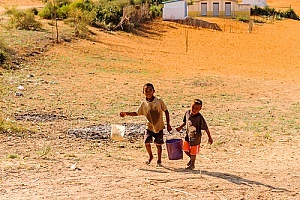In developing countries, up to 80 percent of illnesses are connected to dirty drinking water. Water-related diseases in Africa are particularly problematic, as huge swaths of the continent are unable to access clean water on a daily basis. Providing clean drinking water and educational programs can help resolve this critical health issue. Getting involved with an African charity like The Last Well is a great way to learn more about the water crisis in Africa and to begin helping families live healthier lives. Here are some of the most common water-related diseases in Africa and how you can help eradicate them.

Cholera
Overcrowded communities are frequently affected by cholera, an intestinal infection that, while usually painless, can lead to rapid dehydration and death. Prompt treatment can reduce the number of people who die from cholera to less than 1 percent, though half of people with severe cholera currently die from the disease, according to the World Health Organization (WHO). It is a major problem in Africa. Of the 140,000 cholera cases reported to the WHO in 2000, 87 percent of them occurred in Africa.
Dengue Fever
Dengue is a mosquito-borne infection that causes u-like symptoms. As mosquitos nest in still water, dirty and unused sources of water are often ideal breeding grounds for infected insects. Though dengue rarely causes death, a variation called dengue hemorrhagic fever is potentially lethal. Even in its non-lethal state, dengue can represent a significant loss of income or education to people who must stay home until they have recovered from its often-debilitating effects. Its presence has decreased in recent years, but dengue can still be found in more than 100 countries around the world, including Africa. Eliminating sources of dirty water is the easiest way to eradicate the disease, as there is currently no vaccine.
Hepatitis
Hepatitis A and E, two variations of the common liver inflammation, are caused by inadequate water supplies and poor hygiene. Symptoms typically include fever, weakness, and loss of appetite followed by jaundice. Most infections occur in early childhood, and while nearly all patients recover, certain complications can cause death. Bouts of hepatitis can last from one week to several months, depending on the intensity of the infection. Countries with economies in transition are particularly susceptible to hepatitis, making it important to monitor for the disease in areas that are currently improving their water sanitation efforts.
Malaria
Malaria, another mosquito-borne disease, causes fever, chills, jaundice, vomiting, convulsions, anemia, and even kidney failure. It is one of the leading causes of death 3/5 in children under five years old in Africa, according to the WHO. It is particularly common in African countries south of the Sahara Desert, where deaths number an estimated 1 million each year. Recent reports indicate that climate change may be increasing the area in which malaria-infected mosquitoes are now living, which in turn increases the number of communities impacted. In some cases, constructing better irrigation systems and reservoirs can lessen malaria’s spread.
Prevention and Support
Water-related illnesses are often spread by contaminating drinking water systems with the feces and urine of people and animals who have an illness. Runoff from landfills, sewer pipes, septic elds, and industrial and residential developments can all affect drinking water sources. Mosquitos, which carry malaria and nest in pools of still water, also contribute to disease. To combat the spread of water-related diseases in Africa, communities need to institute better sanitation measures and install drinking water, bathing, and washing facilities that promote improved hygiene and keep water separate from waste. Finances are often the deciding factor in creating access to clean drinking water. Communities often need large amounts of money to build the necessary facilities, representing a major roadblock to achieving safer drinking water sources. In addition, extensive education programs are often needed to ensure that residents are aware of and following proper hygiene techniques in order to keep their water supplies safe. Your charitable donations are therefore essential. You can make a one-time donation, sponsor a village, or even go on a volunteer trip to help communities in their journey towards safe drinking water for all.
Supporting African Charities
The Last Well is working to provide clean drinking water to the entire country of Liberia by the end of 2020 in an effort to eradicate water-related diseases there. The organization builds water systems that give communities easy access to clean water and also provides them with hygiene and sanitation education to help people protect themselves from disease. Get in touch with The Last Well to learn more about Liberia’s water crisis and how you can help support their efforts to give more people access to basic necessities like clean drinking water. The charity accepts one-time donations and monthly sponsorship gifts that go towards helping a village and its residents stay healthy and safe.







